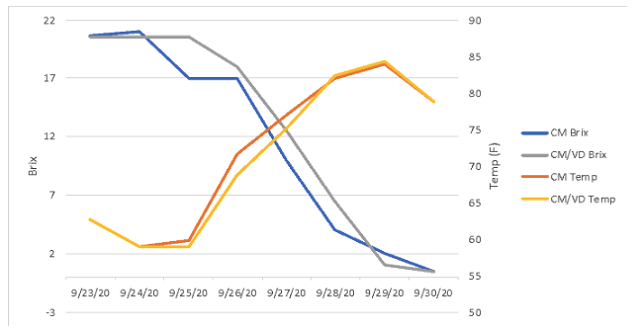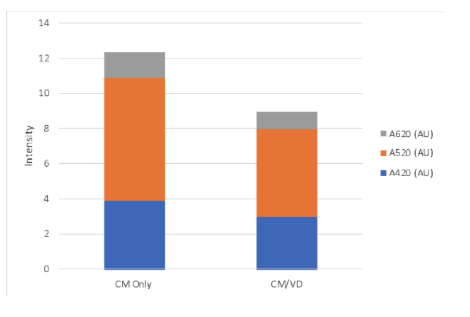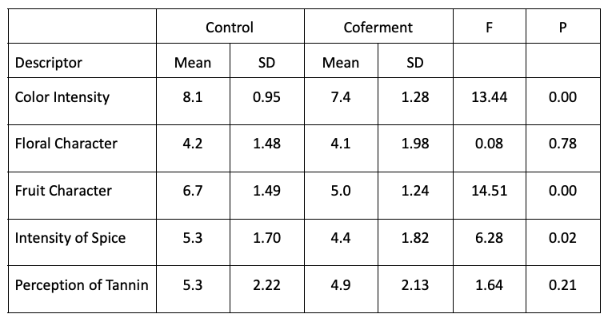Exploring wine style through co-fermentation of Chambourcin and Vidal (2020)
Phil Ponton
Oakencroft Vineyards
Summary
Oakencroft has one of the oldest plantings of Chambourcin in Virginia. The vineyard at Oakencroft typically produces fruit that is concentrated and robust leading to a full-bodied style. However, the winery would also like to produce a lighter style red wine.The purpose of this experiment is to develop a lighter bodied, fruitier style of Chambourcin with enhanced aromatics through co-fermentation with 15% Vidal. Co-fermentation led to a notable reduction in color intensity, however the wines were not significantly different in a triangle test. If co-fermentaiton is to be used for stylistic discrimination, a higher proportion of Vidal will need to be used.
Introduction
Oakencroft has one of the oldest plantings of Chambourcin in Virginia. Chambourcin was originally developed sometime after 1945 by Johannes Seyve as a complex hybrid including parentage of Seyve-Villard, Chancellor, and several other hybridized lines1. Its loose clusters provide good resistance to bunch rots2, and its resistance to mildew (powdery, and to a lesser extent, downy) recommend it for growth in humid climates like Virginia1,2.
Chambourcin produces wines that are initially full of color, though that color can fade over time due to lower levels of the tannins that are needed to form stable polymeric pigments. Aromatic descriptors can include raspberry, clove, cherry, plum, and tobacco2. Jancis Robinson states that the wines are “full-flavored and aromatic without the foxy flavor of some hybrids1” and Tony Wolf calls the “distinct aroma and herbaceous flavors … more vinifera-like than most red hybrids2”. Despite this praise, Chambourcin can also have immature tannins and high acid content that leads to unbalanced wines. It also tends toward reduction, with aromatics of reduced sulfur compounds.
In Virginia, Chambourcin is made into Rosé, lighter bodied Beaujolais-style wines, and longer aged varietal red wines2. The vineyard at Oakencroft typically produces fruit that is concentrated and robust leading to a full-bodied style. However, the winery would also like to produce a lighter style red wine. One option for this is to co-ferment Chambourcin with a white grape variety. Winemakers use co-fermentation for many reasons. Some cite a “lifting of the aromas”, “enhanced texture”, “softening of the wine” or “improved brilliance and intensity of color”5,6. Previous WRE studies with co-fermentation of Chambourcin have noted increased fruit and floral character, but also increased acidity and potential lack of balance (Fabbioli, 2019, Michael Shaps Wineworks, 2019). In both of the previous experiments, only white grape skins were used for co-fermentaiton, not whole berries.
The purpose of this experiment is to develop a lighter bodied, fruitier style of Chambourcin with enhanced aromatics through co-fermentation with Vidal. Vidal was chosen due to similarity in harvest dates, an important practical aspect of co-fermentation. The co-fermented wine included 85% Chambourcin and 15% Vidal while the control wine was 100% Chambourcin.
Methods
Fruit was harvested into lugs on 9/21/20 and chilled on the crush pad overnight (with evening temperature of 42°F). The following day, 1250 lbs (0.625 tons) of Chambourcin was destemmed into one TBin. A second TBin received 1062 lbs of destemmed Chambourcin and 189 lbs of destemmed Vidal (for a total of 0.625 tons) with the addition of 30 ppm SO2 added as potassium metabisulfite. The following day, bins were inoculated with 25 g/hL D254 yeast and 70 ml/ton Color Pro was added to each bin. Two days later, bins were chaptalized to raise the potential alcohol by 1%. Fermentations were punched down twice daily. Fermaid K (20 g/L) was added at when fermentation was 2/3 complete. Bins were pressed at the completion of alcoholic fermentation (on 10/2). Wine was allowed to settle for 4 days, then was racked to neutral French oak barrels. Additional wine was racked to keg for topping. After racking, wine was inoculated with Chris Hanson Viniflora Oenos malolactic bacteria. Malolactic conversion was confirmed to be complete in mid November and 30 ppm SO2 was added. Wine was stored on lees with frequent topping.
Sensory analysis was completed by a panel of 32 wine producers. Due to restrictions put in place during COVID-19, sensory analysis was completed using shipped samples. Each wine producer received three wines in identical bottles, filled on the same day, each coded with random numbers. Two of the bottles contained the same wine while the third bottle contained the different wine. Participants were asked to identify which wine was different (a triangle test). There were four tasting groups with the unique wine in the triangle test balanced among the groups. Participants were then asked to score each wine on a scale of 0 to 10 for color intensity, floral character, fruit character, intensity of spice, and perception of tannin. They were also given open ended questions to describe the wines. Results for the triangle test were analyzed using a one-tailed Z test. Descriptive scores were analyzed using repeated measures ANOVA.
Results
Addition of Vidal to Chambourcin did not cause a large difference in the chemistry of the must (Table 1). Fermentation kinetics were nearly the same between treatments, with robust, warm fermentation complete in five days (Figure 1). Final wine chemistry was also very similar (Table 2). There was a notable difference in color intensity (Figure 2). The 100% Chambourcin wine had a color intensity of 12.4 while the co-fermentation had a lower intensity of 9.0. Free SO2 levels at the time of testing were 22ppm and 23ppm respectively, so this color difference was not due to SO2 bleaching. Curiously, the Chambourcin only wine had lower levels of anthocyanins when tested (Table 3). This testing was done one month after color testing, so some pigment may have been lost during that time. Overall tannin levels were low in this wine, a finding consistent with known levels of tannin in hybrid red wines.
In a triangle test of co-fermented wines, 14 out of 32 respondents were able to distinguish which wine was different, indicating the wines were not significantly different (Z=1.06, p= 0.15). Among participants who correctly identified the different wine in a triangle test, the control wine received higher scores for color, fruit character, and intensity of spice (Table 4). However, based on results from the triangle test, adding 15% Vidal was not enough to produce a different style of wine.
Table 1: Juice chemistry for two treatments of Chambourcin (Virginia Tech Enology Services Lab)

Figure 1: Fermentation kinetics for two treatments of Chambourcin (in-house data)

Table 2: General Chemistry of finished wine (ICV Labs Dec 2020)

Table 3: Phenolic analysis for two treatments of Chambourcin (mg/L) (ICV labs)

Figure 2: Color intensity for two treatments of Chambourcin (ICV Labs, Dec 2020)

Table 4: Statistical analysis for descriptive scores from blind sensory analysis of co-fermented Chambourcin and Vidal

References
(1) Robinson, J.; Harding, J.; Vouillamoz, J. Wine Grapes: A Complete Guide to 1368 Vine Varieties, Including Their Origins and Flavours, Illustrated Edition.; The Penguin Group: New York, 2012.
(2) Wolf, T. K. Wine Grape Production Guide for Eastern North America; Plant and Life Sciences Publishing: Ithaca, New York, 2008.
(3) Springer, L. F.; Sacks, G. Protein-Precipitable Tan- Nin in Wines from Vitis Vinifera and Interspecific Hybrid Grapes (Vitis Ssp.): Differences in Concentration, Extract- Ability, and Cell Wall Binding. Journal of Agricultural and Food Chemistry 62, 7515–7523.
(4) Fanzone, M.; Peña-Neira, A.; Gil, M.; Jofré, V.; Assof, M.; Zamora, F. Impact of Phenolic and Polysaccharidic Composition on Commercial Value of Argentinean Malbec and Cabernet Sauvignon Wines. Food Research International 2012, 45 (1), 402–414.
(5) Robinson, J. The Oxford Companion to Wine, Third Editioin.; Oxford University Press: Oxford, 2006.
(6) Jackson, R. S. Wine Science: Principles and Applications, 4 edition.; Academic Press: Amsterdam, 2014.
(7) Casassa, L. F.; Keirsey, L. S.; Mireles, M. S.; Harbertson, J. F. Cofermentation of Syrah with Viognier: Evolution of Color and Phenolics during Winemaking and Bottle Aging. Am J Enol Vitic. 2012, 63 (4), 538–543.
(8) Wood, V.; Custer, S.; Watson, K.; Chibbaro, B. Virginia 2017 Commercial Grape Report. VCU School of Business 13.
